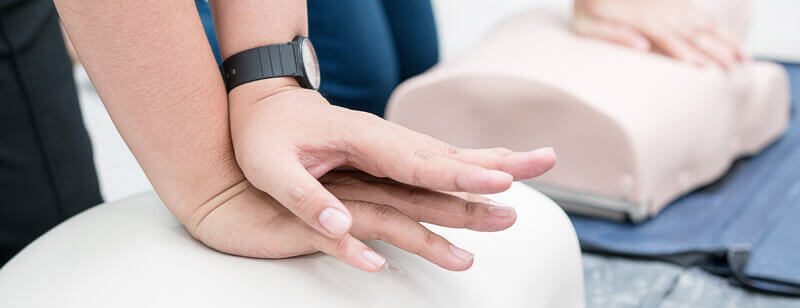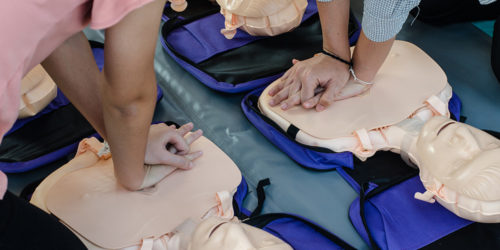Are you interested in CPR training, but have concerns as to whether or not you’ll know what to do and how to respond if you ever happen to come across an emergency situation?
If you’re like most people, chances are that heart attacks and choking incidents aren’t an occurrence that happens every day. In fact, dire medical emergencies for some are rare enough that CPR certification is almost a hobby or a certification that they have for the sake of having. Even if you take a free CPR class for knowledge, however, there’s a big difference between being certified and being prepared in the event of an emergency.
So what CPR mistakes should you be on the lookout for, and what can be done before, during, and after you’ve completed your CPR training to fix those problems?
Here’s an explanation of proper CPR procedures, four common mistakes made when executing CPR, and the ways in which you can address these issues.
How Does CPR Work Anyway?
Part of what makes CPR so effective is that it’s a matter of following key steps in a key order. As such, you don’t have to be a medical professional or a trained expert to step in and save a life. Furthermore, the standard protocols taught over the course of gaining a CPR certification also serve to ensure that providing aid in a medical emergency isn’t something that’s left up to chance.
Now to be clear, this rundown isn’t meant to be a substitute for taking one of our full CPR classes and obtaining formal CPR certification. However, it should give you a quick overview of the steps involved with performing CPR correctly.
Before You Do CPR
Have you ever heard the phrase, “when you have a hammer everything looks like a nail?” Just in case you haven’t, this popular saying is basically a reference to how people often learn a single solution or skill, and then get into the subsequent habit of trying to apply that one solution to every single problem they encounter. Medical emergencies are no different.
That’s why it’s recommended that you go through a few steps before you begin CPR.
1. Assess the Situation
When an emergency has occurred, it isn’t always a good idea to start performing CPR right on the spot. Sometimes it may be necessary to get yourself and the victim to safety before providing medical aid. As such, it’s important to evaluate your environment to ensure that any attempts at CPR are given a greater likelihood of success.
You can do that by asking yourself a few questions.
- Is it safe for yourself and the other person?
- Is the person conscious and responsive?
- Are there other injuries that may also require medical attention?
To be clear, this isn’t meant to be an exhaustive list by any means. However, these are the types of concerns that will have to be addressed before starting CPR.
2. Call 911
Assuming that the victim doesn’t need to be moved, the next thing you want to do is call 911. If there is more than one person present, then have one person call 911 and request an ambulance while the other performs CPR. Let the 911 operator know that an AED is required and provide as much detail on your location and the victim’s injuries as possible.
3. Administer an AED Shock
As any first responder can tell you, medical emergencies can sometimes happen in the strangest places. As such, there’s no guarantee that medical supplies and instruments will be available when they’re needed. That being said, if you have an AED at your disposal, it’s generally recommended that you administer one shock if you are able.
4. Listen For Breathing
The whole purpose of CPR is to keep oxygen circling through the body in an effort to prevent tissue death from occurring right away. In other words, CPR ultimately boils down to giving the other person more time to potentially recover. That’s why it’s essential to listen and see if the person is able to breathe on their own.
According to the guidelines set by the Red Cross, if you hear gasping sounds, that doesn’t count as breathing for the purposes of assessing if there’s a need for CPR. If after 10 seconds, you’re still not hearing sounds of breathing, then your next step is to start doing CPR.
Steps In CPR
Once again, while this isn’t meant to be an extensive guide, here are the fundamental steps of CPR training:
1. Push
The person performing CPR stacks their hands, on top of the other, and places them in the middle of the chest. Relying on body weight, they’ll begin compressions that are approximately two inches deep at a speed of 100 compressions per minute.
2. Breathe
When most people picture CPR, the delivery of mouth to mouth resuscitation is often the image that comes to mind. Tilt the head back, lift the chin, and pinch the nose shut before placing your mouth over the person’s mouth. The idea here is to ensure that air isn’t able to enter or exit anywhere other than the mouth. Provide enough air to raise chest, blow twice, and then continue compressions.
3. Repeat
Continue providing CPR until help arrives, the person begins responding, or an AED becomes available.
What Could Possibly Go Wrong?
Although on paper, CPR can be condensed into just a few steps, it’s not unusual for people to make mistakes while attempting to help someone. Here are a few common CPR mistakes that people often make, as well as some quick troubleshooting advice on how to fix these errors and prevent them from happening.
Mistake #1: Focusing on Minor Injuries
When someone is in a state of medical distress, it’s only natural to want to fix their injuries and reduce their suffering as much as possible. As a matter of fact, solving major problems by shoring up small areas is an effective problem-solving approach outside of an emergency situation. However, when the situation is dire enough that CPR is necessary, taking time away from administering CPR can be dangerous.
The Solution: Disregard minor injuries and focus on using CPR to extend the victim’s window of survival opportunity.
Mistake #2: Not Compressing Hard Enough
As we touched upon previously, CPR is basically made up of rescue breathing and compressions. If you come across someone who has been hurt seriously enough that CPR is in order, it’s only natural to want to avoid adding to that person’s injuries. Due to fear of causing more harm than has already occurred, it’s not uncommon to make the mistake of not pushing hard enough when giving CPR.
The Solution: Although you might hear cracks or pops in the chest while performing CPR, it’s important to compress at least two inches for adult victims and roughly one inch for children.
Mistake #3: Forgetting to Call For Help
At first glance, this mistake may seem surprising. After all, when someone is in need of medical attention, calling an ambulance should be somewhere at the top of the priority list, right? Things can be chaotic in an emergency situation. Depending on the circumstances there may be people screaming and running around, there could be a lot of noise, and in any case, the definition of an emergency is the need for fast and decisive action. When you’re in the throes of such pandemonium and you’re ready to begin CPR, calling for help is definitely a cause for concern.
The Solution: Make sure that you or someone else is able to call for help even if that means putting your phone on speaker as you begin CPR.
Mistake #4: Applying Compressions Too Quickly or Too Slowly
In the heat of the moment, it’s easy to panic and start applying compressions as fast as you can in order to save the victim. By the same token, it’s also possible to have the opposite reaction and slow your compression rate out of a perceived need to be careful and avoid hurting the victim further. The problem with both of these approaches is that they compromise the quality of the CPR being administered to the victim.
The Solution: Try to stick to the standard rate of roughly 100 compressions per minute. If you’re having trouble keeping track, which has been known to happen before, then try to keep count in your head. Another help is to practice compression speed during your CPR training and to revisit that every so often even after you’ve received your CPR certification.
Although CPR is a useful skill to have, in the chaos and panic that often surrounds emergency situations, it’s easy to make mistakes. Some of these issues, like not calling for help, have relatively straightforward fixes. Others, however, like compression rate or exerting the right amount of force while performing CPR may require a bit of practice and fine-tuning to perfect. Regardless, this is where CPR training and CPR certification can prove to be especially useful for people who want to know these skills but aren’t sure how to put it all together.






